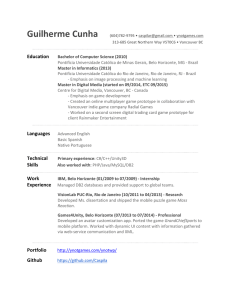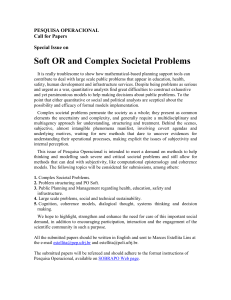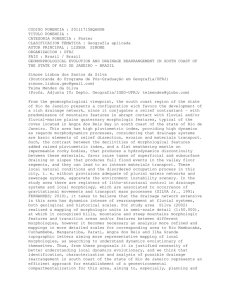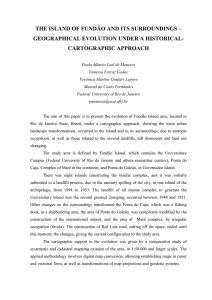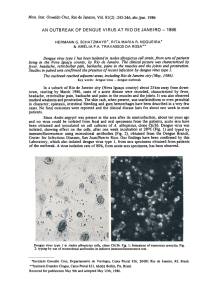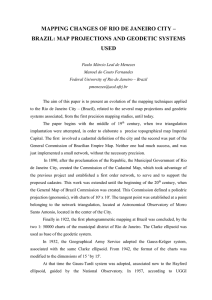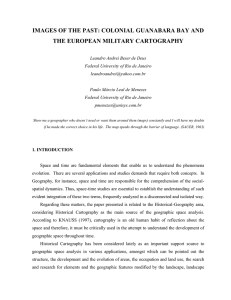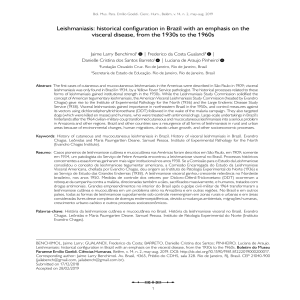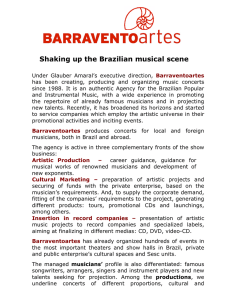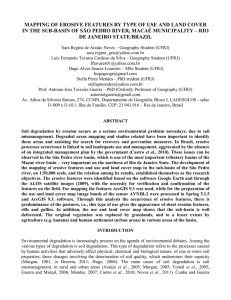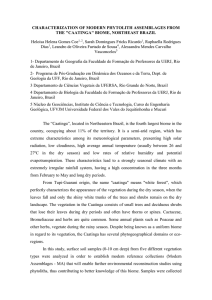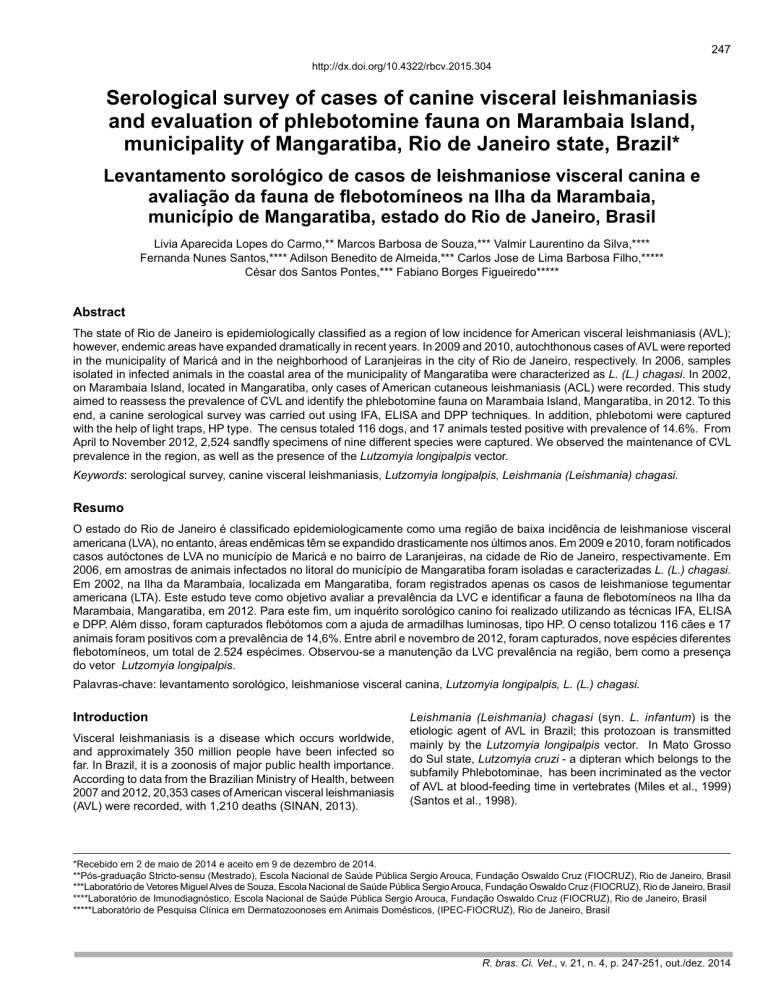
247
http://dx.doi.org/10.4322/rbcv.2015.304
Serological survey of cases of canine visceral leishmaniasis
and evaluation of phlebotomine fauna on Marambaia Island,
municipality of Mangaratiba, Rio de Janeiro state, Brazil*
Levantamento sorológico de casos de leishmaniose visceral canina e
avaliação da fauna de flebotomíneos na Ilha da Marambaia,
município de Mangaratiba, estado do Rio de Janeiro, Brasil
Livia Aparecida Lopes do Carmo,** Marcos Barbosa de Souza,*** Valmir Laurentino da Silva,****
Fernanda Nunes Santos,**** Adilson Benedito de Almeida,*** Carlos Jose de Lima Barbosa Filho,*****
César dos Santos Pontes,*** Fabiano Borges Figueiredo*****
Abstract
The state of Rio de Janeiro is epidemiologically classified as a region of low incidence for American visceral leishmaniasis (AVL);
however, endemic areas have expanded dramatically in recent years. In 2009 and 2010, autochthonous cases of AVL were reported
in the municipality of Maricá and in the neighborhood of Laranjeiras in the city of Rio de Janeiro, respectively. In 2006, samples
isolated in infected animals in the coastal area of the municipality of Mangaratiba were characterized as L. (L.) chagasi. In 2002,
on Marambaia Island, located in Mangaratiba, only cases of American cutaneous leishmaniasis (ACL) were recorded. This study
aimed to reassess the prevalence of CVL and identify the phlebotomine fauna on Marambaia Island, Mangaratiba, in 2012. To this
end, a canine serological survey was carried out using IFA, ELISA and DPP techniques. In addition, phlebotomi were captured
with the help of light traps, HP type. The census totaled 116 dogs, and 17 animals tested positive with prevalence of 14.6%. From
April to November 2012, 2,524 sandfly specimens of nine different species were captured. We observed the maintenance of CVL
prevalence in the region, as well as the presence of the Lutzomyia longipalpis vector.
Keywords: serological survey, canine visceral leishmaniasis, Lutzomyia longipalpis, Leishmania (Leishmania) chagasi.
Resumo
O estado do Rio de Janeiro é classificado epidemiologicamente como uma região de baixa incidência de leishmaniose visceral
americana (LVA), no entanto, áreas endêmicas têm se expandido drasticamente nos últimos anos. Em 2009 e 2010, foram notificados
casos autóctones de LVA no município de Maricá e no bairro de Laranjeiras, na cidade de Rio de Janeiro, respectivamente. Em
2006, em amostras de animais infectados no litoral do município de Mangaratiba foram isoladas e caracterizadas L. (L.) chagasi.
Em 2002, na Ilha da Marambaia, localizada em Mangaratiba, foram registrados apenas os casos de leishmaniose tegumentar
americana (LTA). Este estudo teve como objetivo avaliar a prevalência da LVC e identificar a fauna de flebotomíneos na Ilha da
Marambaia, Mangaratiba, em 2012. Para este fim, um inquérito sorológico canino foi realizado utilizando as técnicas IFA, ELISA
e DPP. Além disso, foram capturados flebótomos com a ajuda de armadilhas luminosas, tipo HP. O censo totalizou 116 cães e 17
animais foram positivos com a prevalência de 14,6%. Entre abril e novembro de 2012, foram capturados, nove espécies diferentes
flebotomíneos, um total de 2.524 espécimes. Observou-se a manutenção da LVC prevalência na região, bem como a presença
do vetor Lutzomyia longipalpis.
Palavras-chave: levantamento sorológico, leishmaniose visceral canina, Lutzomyia longipalpis, L. (L.) chagasi.
Introduction
Visceral leishmaniasis is a disease which occurs worldwide,
and approximately 350 million people have been infected so
far. In Brazil, it is a zoonosis of major public health importance.
According to data from the Brazilian Ministry of Health, between
2007 and 2012, 20,353 cases of American visceral leishmaniasis
(AVL) were recorded, with 1,210 deaths (SINAN, 2013).
Leishmania (Leishmania) chagasi (syn. L. infantum) is the
etiologic agent of AVL in Brazil; this protozoan is transmitted
mainly by the Lutzomyia longipalpis vector. In Mato Grosso
do Sul state, Lutzomyia cruzi - a dipteran which belongs to the
subfamily Phlebotominae, has been incriminated as the vector
of AVL at blood-feeding time in vertebrates (Miles et al., 1999)
(Santos et al., 1998).
*Recebido em 2 de maio de 2014 e aceito em 9 de dezembro de 2014.
**Pós-graduação Stricto-sensu (Mestrado), Escola Nacional de Saúde Pública Sergio Arouca, Fundação Oswaldo Cruz (FIOCRUZ), Rio de Janeiro, Brasil
***Laboratório de Vetores Miguel Alves de Souza, Escola Nacional de Saúde Pública Sergio Arouca, Fundação Oswaldo Cruz (FIOCRUZ), Rio de Janeiro, Brasil
****Laboratório de Imunodiagnóstico, Escola Nacional de Saúde Pública Sergio Arouca, Fundação Oswaldo Cruz (FIOCRUZ), Rio de Janeiro, Brasil
*****Laboratório de Pesquisa Clínica em Dermatozoonoses em Animais Domésticos, (IPEC-FIOCRUZ), Rio de Janeiro, Brasil
R. bras. Ci. Vet., v. 21, n. 4, p. 247-251, out./dez. 2014
248
Didelphis marsupialis and Lycalopex and
Cerdocyon foxes are the reservoirs of L. (L.)
chagasi in forest and rural environments. In
urban areas, in houses and their surroundings,
the primary host is the domestic dog (Canis
familiaris), thus a contributing factor to the
maintenance of the disease cycle (Marzochi,
1994; Franca-Silva et al., 2005).
Canine visceral leishmaniasis (CVL) presents a
wide spectrum of clinical manifestations, ranging
from apparently healthy to severely ill dogs. This
variation is conditioned to the animal’s individual
immunocompetence and the parasite strain
inoculated (Michalick & Genaro, 2005).
According to the AVL control manual (Brasil,
2006), one of the measures of disease control is
epidemiologic surveillance, which is conducted
through serological surveys of the canine
population, removal of seropositive dogs, and
entomological surveys.
The state of Rio de Janeiro is epidemiologically
classified as a region of low incidence of AVL
(Brasil, 2013); however, endemic areas have
expanded dramatically in recent years. In 2009
and 2010, autochthonous cases of AVL were
reported in the municipality of Maricá (de Paula et
al., 2009) and in the neighborhood of Laranjeiras
in the city of Rio de Janeiro (Figueiredo et
al., 2010), respectively. In 2006, samples
Figure 1: Map of the state of Rio de Janeiro with Marambaia Island, municipality of Mangaratiba,
isolated in infected animals in the municipality in highlight. Provided by Barbosa MB.
of Mangaratiba were characterized as L. (L.)
Target population. In 2012, a canine census was conducted
chagasi. In 2002, on Marambaia Island, located
in Mangaratiba, only cases of American cutaneous leishmaniasis in the study area, totaling 116 animals (including stray dogs)
(ACL) were recorded. Although no human cases have been distributed in the ten previously mentioned locations. The
reported in this area, it is important to conduct a new assessment animals were submitted to blood sample collection by puncture
so that the circulation of the disease can be confirmed, and of the external jugular or cephalic veins so that serological
canine prevalence and maintenance of vector presence can tests could be performed. After the samples were collected,
be reassessed. For this reason, this study aims to evaluate the the dogs were electronically identified with microchips, Animall
Tag manufactured, placed in the withers area, thus avoiding
seroprevalence of dogs and the presence of phlebotomine on
information bias, given the fact that dogs in this region move
Marambaia Island, Mangaratiba, state of Rio de Janeiro.
about intensely.
Materials and methods
Area of Study
Marambaia Island is located in the municipality of Mangaratiba,
southern Rio de Janeiro state, Brazil (Figure 1). The island is
administered by the Brazilian Army; it receives military from
several regions of the country and is inhabited by 103 families,
with a total of 352 inhabitants, distributed over an area of
1.6 hectares. The island presents tropical humid climate; its
vegetation comprises one of the last preserves of the Atlantic
Rain Forest in southeastern Brazil, large areas of sandbanks
(including beaches and dunes) and mangrove swamps, with
associated ecosystems (Conde et al 2005; Mattos, 2005).
Marambaia Island’s population is distributed in nine beaches:
Pescaria Velha, Caetana, Cutuca, do José, Grande, Suja, João
Manoel, Caju and Sítio, as well as in a forested area known as
Buraco Quente.
R. bras. Ci. Vet., v. 21, n. 4, p. 247-251, out./dez. 2014
Approximately 5 ml of blood were collected from each dog.
The blood was then centrifuged for 10 minutes at 3000 rpm
for serum separation; with a disposable sterilized pipette, the
serum separated was transferred to Eppendorf microtubes and
preserved at -20 °C until serologic tests started.
Serologic tests. Serologic testing included rapid
immunochromatographic assay (DPP), indirect immunofluorescence
assay (IFA) and enzyme-linked immunosorbent assay (ELISA).
For qualitative serological testing, the rapid test DPP® Canine
Visceral Leishmaniasis (Bio-Manguinhos Fiocruz) was used.
This is a dual-path platform immunochromatographic test that
utilizes rK28 L. (L.) chagasi recombinant protein as antigen to
detect specific antileishmanial antibodies in dogs. The tests were
conducted with samples of the canine sera, according to the
manufacturer’s instructions (Pattabhi et al. 2010).
ELISA was conducted following modifications of the method
described in Voller’s et al. (1976) using L. (L.) chagasi crude
249
antigen (MHOM/BR/74/PP75) produced according to Ribeiro et
al. (2007). The sera were diluted 1:100 in duplicate. The Anti-Dog
IgG peroxidase conjugated, produced in rabbit, Sigma-Aldrich
manufactured, was used as conjugate. The test cut-off point was
calculated based on the average reading of negative sera plus
two standard deviations (Maurice, 1995).
L. longipalpis species was found in only three beaches: Pescaria
Velha, Cutuca and Caetana. N. intermedia species showed wide
distribution, being found mainly at Suja and Pescaria Velha
beaches and in the area known as Vacaria. M. migonei species
was captured in three beaches, José, Pescaria Velha and Suja,
as well as in Vacaria (Chart 3).
For the IFA, logarithmic phase L. (L.) chagasi promastigotes
(MHOM/BR/74/PP75), fixed in formalin at 2%, were used as
antigen. The sera were diluted from 1:40 to lack of reactivity.
The Anti-Dog IgG-FITC conjugate, developed in rabbits, SigmaAldrich manufactured, was used as antigen. The samples that
showed reactivity as from serum dilution 1:40 were considered
positive (Rebonato & Camargo, 1969).
Collection Sites
In this study, indirect immunofluorescence assay (IFA) was used
to confirm diagnosis, according to the manual provided by the
Brazilian Ministry of Health (Brasil, 2006). This criterion was
adopted to allow comparison with the 2009 serological survey.
Assessment of the phlebotomine fauna. HP suction light
traps were placed in the houses and their surroundings,
such as kennels and chicken roosts, as well as in the forest
environment. The traps were set at 6 PM and removed at 7 AM
the next morning (Pugedo et al, 2005). Collection occurred on
a monthly basis, on three consecutive days, from
April to November 2012.
Collection was performed in eleven sites: in the
beaches named Pescaria Velha, Caetana, Suja,
do José, Grande, Cutuca, Sítio, Caju; in the areas
known as Buraco Quente and Vacaria; and at the
Hotel dos Sargentos (Hotel of the Sergeants).
The specimens collected were stored in Eppendorf
microtubes containing 70% alcohol. The tubes were
properly identified and sent to the Miguel Alves de
Souza Laboratory of Vectors - ENSP/FIOCRUZ,
for clarification, mounting and species identification
according to the nomenclature proposed by Galati
(2003).
The statistical analysis was performed descriptively
evaluating the frequency of the findings.
Results
Serology. One hundred sixteen (116) canine serum
samples were analyzed: 13 (11.2%) were positive in
the DPP, 45 (38.79%) in the ELISA and 17 (14.65%)
in the IFA.
Twelve of these samples (10.34%) showed agreement
in all serological tests performed. The seropositive
dogs are distributed on the following beaches: Suja,
Caetana, Grande, Pescaria Velha, José and Caju
(Chart 1).
Phlebotomine Fauna. Nine phlebotomus species were
found in the region: Lutzomyia longipalpis, Nyssomyia
intermedia, Migoneimyia migonei, Pintomyia fischeri,
Evandromyia edwardsi, Micropygomyia capixaba,
Pintomyia bianchigalatiae, Micropygomyia schreiberi
and Bruptomyia sp. (Chart 2).
DISTRIBUTION OF SEROPOSITIVE
ANIMALS
Suja Beach
Caetana Beach
Pescaria Velha Beach
Grande Beach
Caju Beach
José Beach
Cutuca Beach
Sítio Beach
Buraco Quente
5
4
3
3
1
1
0
0
0
TOTAL
17
Chart 1: Distribution of seropositive dogs per collection site. Marambaia
Island, municipality of Mangaratiba, 2012
SPECIES
MALE
%
FEMALE
%
TOTAL
%
N. intermedia
1029
77,07
1016
85,5
2045
81
M. migonei
263
19,7
141
11,92
404
16
L. longipalpis
34
2,55
6
0,5
40
1,6
P. fischeri
4
0,3
16
1,3
20
0,8
M. schreiberi
4
0,3
6
0,5
10
0,4
M. capixaba
0
0
2
0,1
2
0,08
P. bianchigalatiae
0
0
1
0,09
1
0,04
E. edwardsi
1
0,08
1
0,09
2
0,08
TOTAL
1335
100
1189
100
2524
100
Chart 2: Phlebotomine fauna on Marambaia Island, from April to November 2012
Collection Sites
Distribution of the species
L.longipalpis
N. intermedia
M. migonei
Suja Beach
Absent
Present
Present
Caetana Beach
Present
Present
Present
Pescaria Velha Beach
Present
Present
Present
Grande Beach
Absent
Present
Present
Caju Beach
Absent
Present
Absent
José Beach
Absent
Present
Present
Cutuca Beach
Present
Present
Present
Sítio Beach
Absent
Present
Present
Buraco Quente
Absent
Absent
Absent
Vacaria
Absent
Present
Present
Chart 3: Distribution of the species L. longiplapis, N. intermedia and M. migonei in the
collection sites. Marambaia Island, municipality of Mangaratiba, 2012
R. bras. Ci. Vet., v. 21, n. 4, p. 247-251, out./dez. 2014
250
Discussion
Currently, canine visceral leishmaniasis is a serious public health
problem in expansion in Brazil, mainly in urban areas previously
considered unaffected (Costa, 2008).
The confirmation that 17 (14.65%) dogs tested positive for CVL on
Marambaia Island in 2012 reveals a region with a high prevalence
of the disease. The island, which belongs to the Armed Forces,
prohibits the entry and exit of animals; therefore, we suspect that
the cases of CVL may be indigenous. This prevalence is close
to the findings by Silva et al. (2013), who reported prevalence
of 11.59% for CVL in Mangaratiba, Rio de Janeiro state. This
finding corroborates Paranhos-Silva et al. (1996), who carried out
a cross-sectional study in Bahia state, and found prevalence of
23.5%. In the municipality of Bom Sucesso, Minas Gerais state,
prevalence of 10.8% was reported in a survey conducted in two
neighborhoods (Silva & Santa Rosa, 2005).
Most dogs roam freely across the island during the day and
return to their owners’ houses at twilight. At this time of day, the
risk of exposure to the AVL vector is high.
The study area, Marambaia Island, holds an Atlantic Rain Forest
preserve. Its population is distributed in homes installed near the
forest environment or even in the woods. Anthropic changes in
the natural environment, poor sanitation, lack of sewage system
and regular garbage collection, as well as the presence of chicken
roosts in backyards, causes the accumulation of organic matter
around the dwellings, promoting the creation of an environment
favorable for sand flies. Cerbino et al (2009), in a study conducted
in Teresina, Piauí state, between 1991 and 2000, found that vast
vegetation and population increase are related to increased rates
of the disease. Monteiro et al (2005), in a study conducted in
the municipality of Montes Claros, Minas Gerais state, reported
that substandard housing conditions, low socioeconomic status,
and lack of basic sanitation, along with very close interaction with
domestic animals, increase the risk of AVL transmission.
The occurrence of CVL in the study area may be related to
a specific characteristic of this region, with the houses are
inserted in the woods, where the presence of the vector and
wild reservoirs is abundant, and garbage collection is irregular
with large accumulation of organic matter in the surroundings
of residences.
The phlebotomine fauna on Marambaia Island was studied
in 2009 by Novo et al. (2013), who reported a total of thirteen
species collected in three different ecotopes: domiciliary, peridomiciliary and forest, with N. intermedia species found in higher
density and distributed throughout the region. The presence of
L. longipalpis species was observed, but at low density.
In our study, N. intermedia is still the phlebotomus species
presenting the highest density, followed by M. migonei, L.
longipalpis and P. fischeri. Such species are of great vector
relevance for leishmaniasis. L. longipalpis was found with
reduced density in only three beaches: Pescaria Velha, Cutuca
and Caetana. Brandão-Filho et al (2002) conducted a study at
the region of Zona da Mata, Pernambuco state, and described
the presence of AVL cases with no record of L. longipalpis,
which suggests the involvement of another vector species of
the disease, such as M. migonei.
The low density, or even the absence of L. longipalpis, might
explain the absence of human cases in the study area. According
to Souza et al (2003), in the west part of the city of Rio de
Janeiro, autochthonous CVL cases have occurred for years
with no record of L. longiplapis presence, which can also be
related to the participation of another phlebotomus species in the
transmission cycle, whose feeding habits are targeted at dogs
and other domestic animals.
In the present study, we observe the occurrence of CVL on
Marambaia Island, and that the phlebotomine fauna has
maintained the same patterns, thus contributing to greater
knowledge on the dynamics of this disease in the region.
Acknowledgments
This study was supported by Rio de Janeiro Research Foundation – FAPERJ – Project “Jovem Cientista do Nosso Estado” and
Research on Reemerging and Neglected Diseases. Fabiano Borges Figueiredo holds a grant from the Brazilian Council for Scientific
and Technological Development - CNPq for productivity in research.
References
BRANDÃO-FILHO SP, SILVA OA, ALMEIDA EL, VALENÇA
HF, ALMEIDA FA. Incidência da leishmaniose visceral sem
a presença de Lutzomyia longipalpis, na Zona da Mata de
Pernambuco, Brasil. Revista Sociedade Brasileira Medicina
Tropical, n. 35 (Supl 1), p. 333, 2002.
BRASIL, Ministério da Saúde – Manual de vigilância e controle da
leishmaniose visceral. Brasília, Ministério da Saúde, 2006
BRASIL, Ministério da Saúde. Municípios considerados de
transmissão esporádica no período de 2009 a 2011. Avaliable
from: http: // portal . saúde . gov . br / portal / arquivos / pdf /
2012_11_lv_transmissão_esporadica_2009_a_2011.pdf., 2013.
CAMARGO ME, REBONATO C. Cross-reactivity in fluorescence
tests for Trypanosoma and Leishmania antibodies. A simple
inhibition procedure to ensure specific results. American Journal
of Tropical Medicine and Hygiene v. 18, p. 500-505, 1969.
R. bras. Ci. Vet., v. 21, n. 4, p. 247-251, out./dez. 2014
CERBINO NETO J, WERNECK GL, COSTA CHN. Factors
associated with the incidence of urban visceral leishmaniasis:
an ecological study in Teresina, Piauí State, Brazil. Cadernos de
Saúde Pública v. 25, p.1543-1551, 2009.
CONDE MMS, LIMA HRP, PEIXOTO AL. Aspectos florísticos e
vegetacionais da Marambaia, Rio de Janeiro, Brasil. In: História
Natural da Marambaia. Editora da Universidade Federal Rural do
Rio de Janeiro, Seropédica, p. 133-168, 2005.
COSTA CHN. Characterization and speculations on the
urbanization of visceral leishmaniasis in Brazil. Cadernos de
Saúde Pública, v. 24, p. 2959-2963, 2008.
COUTINHO SG, NUNES MP, MARZOCHI MCA, TRAMONTANO
NA. Survey for American cutaneous and visceral leishmaniasis
among 1342 dogs from areas in Rio de Janeiro (Brazil) where the
human diseases occur. Memórias do Instituto Oswaldo Cruz, v.
80, p.17-22, 1985.
251
de PAULA CC, FIGUEIREDO FB, MENEZES RC, MOUTACONFORT E, BOGIO A, MADEIRA MF. Canine visceral
leishmaniasis in Maricá, State of Rio de Janeiro: first report of an
autochthonous case. Revista Sociedade Brasileira de Medicina
Tropical, v. 42, p. 77-78, 2009.
FRANÇA-SILVA JC, BARATA RA, COSTA RT, MONTEIRO
EM, MACHADO-COELHO GL, VIEIRA EP et al. Importance
of Lutzomyia longipalpis in the dynamics of transmission of
canine visceral leishmaniasis in the endemic area of Porteirinha
Municipality, Minas Gerais, Brazil. Veterinary Parasitologyv. 131,
p. 213-220, 2005.
FIGUEIREDO FB, BARBOSA FILHO CJ, SCHUBACH EY,
PEREIRA SA, NASCIMENTO LD, MADEIRA M F. Relato de
caso autóctone de leishmaniose visceral canina na zona sul do
município do Rio de Janeiro. Revista Sociedade Brasileira de
Medicina Tropical, v. 43, p. 98-99, 2010.
GALATI EAB. Classificação de Phlebotominae. In: RANGEL, E.F,
LAINSON, R. Flebotomíneos do Brasil. Rio de Janeiro. Editora
Fiocruz, p. 23-51, 2003
HOMMEL M, PEKIS W, RANQUE J, QUILICI M, LANOTTE
G. The micro-ELISA technique in the serodiagnosis of visceral
leishmaniasis. Annals of Tropical Medicine and Parasitology, v.
72, p. 213-218, 1978.
MADEIRA MF, SCHUBACH AO, SCHUBACH TMP, PEREIRA
SA, FIGUEIREDO FB, BAPTISTA C, et al. Post mortem
parasitological evaluation of dogs seroreactive for Leishmania
from Rio de Janeiro, Brazil. Vet Parasitol v. 138, p. 3-4, p. 366370, 2006.
MATTOS CCLV. Caracterização climática da restinga da
Marambaia, RJ. In: Menezes, LFT, Peixoto AL and Araújo
DSD. (Eds.). História Natural da Marambaia. Rio de Janeiro:
Universidade Federal Rural do Rio de Janeiro, p. 55-66, 2005.
MAURICIO I, CAMPINO L, ABRANCHES P. [Quality control of
the micro-ELISA technic applied to the diagnosis of human and
canine visceral leishmaniasis]. Acta Médica Portuguesav. v. 8, p.
607-611, 1995.
MICHALICK MSM, Genaro O. Leishmaniose Visceral Americana.
In: NEVES DP, MELO AL, LINARDI PM, VITOR RWA. (Ed.)
Parasitologia humana. 11. ed. São Paulo: Editora Atheneu, p.
56-72, 2005.
MILES MA, VEXENAT JA, FURTADO CAMPOS JH, FONSECA
DE CASTRO JA. Canine leishmaniasis in Latin America: control
strategies for visceral leishmaniasis. In: International Canine
Leishmaniasis Forum, 1999. Barcelona. Proceedings...Barcelona:
Killick-Kendrick, p. 46-53, 1999.
MONTEIRO EM, SILVA JC, COSTA RT, COSTA DC, BARATA
RA, PAULA EV, MACHADO-COELHO GL, ROCHA MF,
FORTES-DIAS CL, DIAS ES. Visceral leishmaniasis: a study on
phlebotomine sand flies and canine infection in Montes Claros,
State of Minas Gerais. Revista Sociedade Brasileira de Medicina
Tropical v. 38, p. 147-152, 2005.
NOVO SPC, SOUZA MB, VILLANOVA CB, CAETANO JM, MEIRA
AM. Survey of sandfly vectors of leishmaniasis in Marambaia
Island, municipality of Mangaratiba, state of Rio de Janeiro, Brazil.
Revista Sociedade Brasileira de Medicina Tropical v. 46, p. 2, 2013.
PARANHOS-SILVA, M., FREITAS, L. A., SANTOS, W. C.,
GRIMALDI, G., PONTES-DE-CARVALHO, L. C., & OLIVEIRADOS-SANTOS, A. J. A cross-sectional serodiagnostic survey of
canine leishmaniasis due to Leishmania chagasi. The American
Journal of Tropical Medicine and Hygiene, v. 55, n.1, p. 39-44,
1996.
PATTABHI S, WHITTLE J, MOHAMATH R, EL-SAFI S,
MOULTON GG, GUDERIAN JA, et al. Design, development and
evaluation of rK28-based point-of-care tests for improving rapid
diagnosis of visceral leishmaniasis. PLoS Negl Trop Dis v. 4, n. 9,
2010.
PUGEDO H, BARATA R A, FRANÇA-SILVA J C, SILVA J C,
DIAS E S. HP: um modelo aprimorado de armadilha luminosa de
sucção para a captura de pequenos insetos. Revista Sociedade
Brasileira de Medicina Tropical v. 38, p.70-72, 2005.
RIBEIRO FC, DE O SCHUBACH A, MOUTA-CONFORT E,
SCHUBACH TM, MADEIRA FM, MARZOCHI MC. Use of ELISA
employing Leishmania (Viannia) braziliensis and Leishmania
(Leishmania) chagasi antigens for the detection of IgG and IgG1
and IgG2 subclasses in the diagnosis of American tegumentary
leishmaniasis in dogs. Veterinary Parasitology v. 148, p. 200-206,
2007.
SANTOS SO, ARIAS J, RIBEIRO AA, HOFFMANN MP, FREITAS
RU, MALACCO MAF. Incrimination of Lutzomyia cruzi as a vector
of American Visceral Leishmaniasis. Medical and Veterinary
Entomology v. 12, p. 315-317, 1998.
SILVA, C. B. D., VILELA, J. A. R., PIRES, M. S., SANTOS,
H. A., FALQUETO, A., PEIXOTO, M. P., & MASSARD, C. L.
Seroepidemiological aspects of Leishmania spp. in dogs in the
Itaguai micro-region, Rio de Janeiro, Brazil. Revista Brasileira de
Parasitologia Veterinária, v. 22, n. 1, p. 39-45, 2013.
SILVA M.R. & SANTA ROSA I.C.A. Levantamento de
leishmaniose visceral canina em Bom Sucesso, Minas Gerais.
Acta Scientiae Veterinariae. v. 33, p. 69-74, 2005.
SOUZA MB, MARZOCHI MC, DE CARVALHO RW, RIBEIRO PC,
PONTES CS, CAETANO JM, MEIRA AM. Ausência da Lutzomyia
longipalpis em algumas áreas de ocorrência de leishmaniose
visceral no Município do Rio de Janeiro. Cadernos de Saúde
Pública v. 19, p. 6, 2003.
VOLLER A, BIDWELL DE, BARTLETT ANN. Enzime
immunoassays in diagnostic medicine. Theory and practice. Bull
World Health Organ , v. 53, p. 55-65, 1976.
R. bras. Ci. Vet., v. 21, n. 4, p. 247-251, out./dez. 2014

